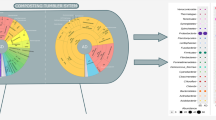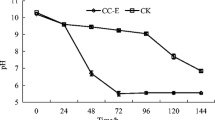Abstract
The method of continuous thermophilic composting (CTC) remarkably shortened the active composting cycle and enhanced the compost stability. Effects of CTC on the quantities of bacteria, with a comparison to the traditional composting (TC) method, were explored by plate count with incubation at 30, 40 and 50°C, respectively, and by quantitative PCR targeting the universal bacterial 16S rRNA genes and the Bacillus 16S rRNA genes. The comparison of cultivatable or uncultivatable bacterial numbers indicated that CTC might have increased the biomass of bacteria, especially Bacillus spp., during the composting. Denaturing gradient gel electrophoresis (DGGE) analysis was employed to investigate the effects of CTC on bacterial diversity, and a community dominated by fewer species was detected in a typical CTC run. The analysis of sequence and phylogeny based on DGGE indicated that the continuously high temperature had changed the structure of bacterial community and strengthened the mainstay role of the thermophilic and spore-forming Bacillus spp. in CTC run.





Similar content being viewed by others
References
Adams JDW, Frostick LE (2009) Analysis of bacterial activity, biomass and diversity during windrow composting. Waste Manag 29:598–605
Amann RI, Ludwig W, Schleifer KH (1995) Phylogenetic identification and in situ detection of individual microbial cells without cultivation. Microbiol Rev 59:143–169
Aslanidis C, de Jong PJ (1990) Ligation-independent cloning of PCR products (LIC-PCR). Nucl Acids Res 18:6069–6074
Beffa T, Blanc M, Marilley L, Fischer JL, Lyon PF, Aragno M (1996) Taxonomic and metabolic microbial diversity during composting. In: de Bertoldi M, Sequi P, Lemmes B, Papi T (eds) The science of composting. Part 1. Chapman and Hall, London, pp 149–161
Belete L, Egger W, Neunhãuserer C, Caballero B, Insam H (2001) Can community level physiological profiles be used for compost maturity testing? Compost Sci Util 9:6–18
Birnboim HC, Doly J (1979) A rapid alkaline extraction procedure for screening recombinant plasmid DNA. Nucl Acids Res 7:1513–1523
Buchholz-Cleven BEE, Rattunde B, Straub KL (1997) Screening for genetic diversity of isolates of anaerobic Fe(II)-oxidizing bacteria using DGGE and whole-cell hybridization. Syst Appl Microbiol 20:301–309
Chroni C, Kyriacou A, Georgaki I, Manios T, Kotsou M, Lasaridi K (2009) Microbial characterization during composting of biowaste. Waste Manag 29:1520–1525
Danon M, Franke-Whittle IH, Insam H, Chen Y, Hadar Y (2008) Molecular analysis of bacterial community succession during prolonged compost curing. FEMS Microbiol Ecol 65:133–144
Droffner ML, Brinton WF Jr, Evans E (1995) Evidence for the prominence of well characterized mesophilic bacteria in thermophilic (50–70°C) composting environments. Biomass Bioenerg 8:191–195
Franke-Whittle IH, Knapp BA, Fuchs J, Kaufmann R, Insam H (2009) Application of COMPOCHIP microarray to investigate the bacterial communities of different composts. Microb Ecol 57:510–521
Fuerhacker M, Haberl R (1995) Composting of sewage sludge in a rotating vessel. Water Sci Technol 32:121–125
Joo HS, Hirai M, Shoda M (2006) Piggery wastewater treatment using Alcaligenes faecalis strain No.4 with heterotrophic nitrification and aerobic denitrification. Water Res 40:3029–3036
Kanzler BEM, Pfannes KR, Vogl K, Overmann J (2005) Molecular characterization of the nonphotosynthetic partner bacterium in the consortium "Chlorochromatium aggregatum". Appl Environ Microbiol 71:7434–7441
Kindaichi T, Kawano Y, Ito T, Satoh H, Okabe S (2006) Population dynamics and in situ kinetics of nitrifying bacteria in autotrophic nitrifying biofilms as determined by real-time quantitative PCR. Biotechnol Bioeng 94:1111–1121
Larney FJ, Yanke LJ, Miller JJ, McAllister TA (2003) Fate of coliform bacteria in composted beef cattle feedlot manure. J Environ Qual 32:1508–1515
Lim J, Do H, Shin SG, Hwang S (2008) Primer and probe sets for group-specific quantification of the genera Nitrosomonas and Nitrosospira using real-time PCR. Biotechnol Bioeng 99:1374–1383
Mayhew LE, Swanner ED, Martin AP, Templeton AS (2008) Phylogenetic relationships and functional genes: distribution of a manganese-oxidizing gene (mnxG) in Bacillus species. Appl Environ Microbiol 74:7265–7271
Mayumi D, Akutsu-Shigeno Y, Uchiyama H, Nomura N, Nakajima-Kambe T (2008) Identification and characterization of novel poly(dl-lactic acid) depolymerases from metagenome. Appl Environ Microbiol 79:743–750
McCaig AE, Anne Glover L, Prosser JI (1999) Molecular analysis of bacterial community structure and diversity in unimproved and improved upland grass pastures. Appl Environ Microbiol 65:1721–1730
Mergaert J, Swings J (1996) Biodiversity of microorganisms that degrade bacterial and synthetic polyesters. J Ind Microbiol 17:463–469
Miyatake F, Iwabuchi K (2005) Effect of high compost temperature on enzymatic activity and species diversity of culturable bacteria in cattle manure compost. Bioresour Technol 96:1821–1825
Murray AE, Hollibaugh JT, Orrego C (1996) Phylogenetic compositions of bacterioplankton from two California estuaries compared by denaturing gradient gel electrophoresis of 16S rDNA fragments. Appl Environ Microbiol 62:2676–2680
Muyzer G, Brinkhoff T, Ulrich N, Santegoeds C, SchÄfer H, Wawer C (1998) Denaturing gradient gel electrophoresis (DGGE) in microbial ecology. Mol Microb Ecol Man 3.4.4:1–27
Nakamura Y, Satoh H, Kindaichi T, Okabe S (2006) Community structure, abundance, and in situ activity of nitrifying bacteria in river sediments as determined by the combined use of molecular techniques and microelectrodes. Environ Sci Technol 40:1532–1539
Nakasaki K, Shoda M, Kubota H (1985) Effect of temperature on composting of sewage sludge. Appl Environ Microbiol 50:1526–1530
Reasoner DJ, Geldreich EE (1985) A new medium for the enumeration and subculture of bacteria from potable water. Appl Environ Microbiol 49:1–7
Ryckeboer J, Mergaert J, Vaes K, Klammer S, De Clercq D, Coosemans J et al (2003) A survey of bacteria and fungi occurring during composting and self-heating processes. Ann Microb 53:349–410
Schulze KL (1962) Continuous thermophilic composting. Appl Environ Microbiol 10:108–122
Sébastien D, Myriam S, Barbara JM, Marcel MMK, Chuck RF, Nicole D (2007) Diversity, relative abundance and metabolic potential of bacterial endosymbionts in three Bathymodiolus mussel species from cold seeps in the Gulf of Mexico. Environ Microbiol 9:1423–1438
Shaver YJ, Nagpal ML, Rudner R, Nakamura LK, Fox KF, Fox A (2002) Restriction fragment length polymorphism of rRNA operons for discrimination and intergenic spacer sequences for cataloging of Bacillus subtilis sub-groups. J Microbiol Meth 50:215–223
Strom PF (1985) Effect of temperature on bacterial species diversity in thermophilic solid-waste composting. Appl Environ Microbiol 50:899–905
Strom PF (1985) Identification of thermophilic bacteria in solid-waste composting. Appl Environ Microbiol 50:906–913
Suler DJ, Finstein MS (1977) Effect of temperature, aeration, and moisture on co2 formation in bench-scale, continuously thermophilic composting of solid waste. Appl Environ Microbiol 33:345–350
Székely AJ, Sipos R, Berta B, Vajna B, Hajdú C, Márialigeti K (2009) DGGE and T-RFLP analysis of bacterial succession during mushroom compost production and sequence-aided T-RFLP Profile of mature compost. Microb Ecol 57:522–533
Tang JC, Shibata A, Zhou Q, Katayama A (2007) Effect of temperature on reaction rate and microbial community in composting of cattle manure with rice straw. J Biosci Bioeng 104:321–328
Torsvik V, GoksÖyr J, Daae FL (1990) High diversity in DNA of soil bacteria. Appl Environ Microbiol 56:782–787
Vallaeys T, Topp E, Muyzer G, Macheret V, Laguerre G, Rigaud A, Soulas G (1997) Evaluation of denaturing gradient gel electrophoresis in the detection of 16S rDNA sequence variation in rhizobia and methanotrophs. FEMS Microbiol Ecol 24:279–285
Wakase S, Sasaki H, Itoh K, Otawa K, Kitazume O, Nonaka J, Satoh M, Sasaki T, Nakai Y (2008) Investigation of the microbial community in a microbiological additive used in a manure composting process. Bioresour Technol 99:2687–2693
Ward DM, Bateson MM, Weller R, Ruff-Roberts AL (1992) Ribosomal RNA analysis of microorganisms as they occur in nature. Adv Microbiol Ecol 12:219–286
Wong JWC, Li SWY, Wong MH (1995) Coal fly ash as a composting material for sewage sludge: effects on microbial activities. Environ Technol 16:527–537
Xiao Y, Zeng GM, Yang ZH, Shi WJ, Huang C, Fan CZ, Xu ZY (2009) Continuous thermophilic composting (CTC) for rapid biodegradation and maturation of organic municipal solid waste. Bioresour Technol 100:4807–4813
Xiao Y, Zeng GM, Yang ZH, Liu YS, Ma YH, Yang L, Wang RJ, Xu ZY (2009) Coexistence of nitrifiers, denitrifiers and Anammox bacteria in a sequencing batch biofilm reactor as revealed by PCR-DGGE. J Appl Microbiol 106:496–505
Yang ZH, Xiao Y, Zeng GM, Xu ZY, Liu YS (2007) Comparison of methods for total community DNA extraction and purification from compost. Appl Microbiol Biotechnol 74:918–925
Yu Y, Kim J, Hwang S (2006) Use of real-time PCR for group-specific quantification of aceticlastic methanogens in anaerobic processes: population dynamics and community structures. Biotechnol Bioeng 93:424–433
Zbinden M, Cambon-Bonavita MA (2003) Occurrence of deferribacterales and entomoplasmatales in the deep-sea Alvinocarid shrimp rimicaris exoculata gut. FEMS Microbiol Ecol 46:23–30
Acknowledgments
This study was financially supported by the Program for Changjiang Scholars and Innovative Research Team in University of China (IRT0719), the National Basic Research Program (973 Program) (2005CB724203), the National Natural Science Foundation of China (50978088 and 30970105), and the Hunan Key Scientific Research Project (2009FJ1010). Finally, the authors are very grateful to two anonymous reviewers who contributed to improving the manuscript both in terms of quality and comprehensibility.
Author information
Authors and Affiliations
Corresponding author
Rights and permissions
About this article
Cite this article
Xiao, Y., Zeng, GM., Yang, ZH. et al. Effects of Continuous Thermophilic Composting (CTC) on Bacterial Community in the Active Composting Process. Microb Ecol 62, 599–608 (2011). https://doi.org/10.1007/s00248-011-9882-z
Received:
Accepted:
Published:
Issue Date:
DOI: https://doi.org/10.1007/s00248-011-9882-z




